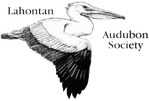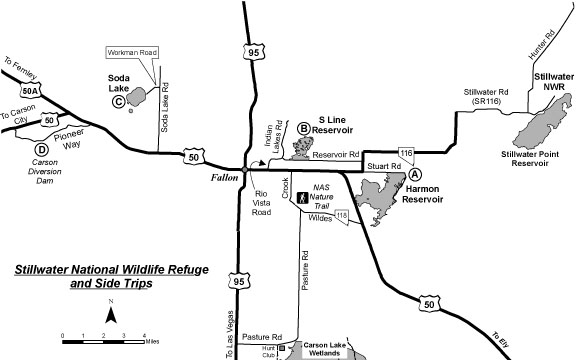 Red-necked Phalarope - Photo by Steve Ting Red-necked Phalarope - Photo by Steve Ting WHAT TO EXPECT: Stillwater National Wildlife Refuge (NWR), located 73 miles east of Reno, usually requires at least a full day trip. The refuge is located on the edge of the Carson Sink, which is the terminus of the Carson River and consists of numerous wetland units that are managed to maintain natural biological diversity. The 80,000-acre refuge is a designated Western Hemisphere Shorebird Reserve and a significant stopover for migrants along the Pacific Flyway. Stop at the Stillwater NWR Headquarters before entering the refuge (details below). Stillwater NWR is part of the Lahontan Valley Wetlands Nevada Important Bird Area. BEST TIME OF YEAR: All year is productive, with tens of thousands of shorebirds from late April to mid-May and, again, July through September. Waterfowl, sometimes in the hundreds of thousands, arrive in late fall. NOTABLE SPECIES: Shorebirds and wading birds are abundant spring through fall, including good numbers of American White Pelican, White-faced Ibis, and Wilson's and Red-necked Phalaropes. Snowy Plover nests here. Tundra Swans gather in early winter. The refuge is Nevada's largest Bald Eagle winter residence. Approximately half the Canvasback population in the Pacific Flyway winter here. Wintering raptors include Golden Eagle, Rough-legged Hawk, and Prairie Falcon. Over 220 species have been recorded here. This area has produced a number of rarities; check the Nevada Birds List Server and eBird below. eBird Hotspot Link PRECAUTIONS: Exercise caution driving along the refuge roads during wet weather to avoid becoming mired in muddy dirt roads or shoulders. Plan for sufficient drinking water as well as protection from the elements, especially during warmer months. HOW TO GET THERE: From the I-80 & US 395 interchange, drive east on I-80 for approximately 32 miles to Exit 48, the second Fernley exit; bear right and over the railroad overpass. Enter the roundabout and exit east onto US 50. Continue 26 miles to Fallon. (Side Trip A) Proceed 12.3 miles on Stillwater Road/SR 116, which turns into East County Road. Stop at the Stillwater NWR Headquarters (U.S. Fish and Wildlife Service) - 1020 New River Parkway, #305, Fallon 89407 (775-423-5128). Just east of Fallon, NV, turn south on Harrigan Road and go a little over one half mile, then turn east on New River Parkway and take the first right. The refuge office is on the east end of the building. To get to the actual refuge, go about four and a half miles east of Fallon, NV on Highway 50, then head east on State Route 116, otherwise known as Stillwater Road. Stay on Stillwater Road for another twelve miles. You’ve reached the refuge when the pavement ends, but you’ll need to keep going to find the marsh! Google Map of the Area POPULAR BIRDING ROUTE: Just beyond the refuge maintenance shop area on the right, park at Stillwater Point Reservoir (restrooms). A short path leads to a large interpretive viewing platform overlooking open water and wetlands. A new, one-way interpretive Auto Tour Route, planned for early 2008, begins at Stillwater Point Reservoir. It travels the perimeter of Duff's Pond, crosses between Upper and Lower Foxtail lakes, and leads west to Hunter Road. Turn left (south) to return to Stillwater Road/SR 116, or turn right (north) and follow the route described below. To access areas farther north in Stillwater NWR directly from Stillwater Point Reservoir, backtrack 0.4 mile from the parking lot to Hunter Road and turn north into the refuge entrance. Follow the roads depicted on the refuge map (available at the headquarters in Fallon). Two of the best birding areas are (1) along the dike separating the Nutgrass unit from Goose Lake and (2) from the road along the south end of the Big Water unit, located at the end of Nutgrass Road. Return to Stillwater Road/SR 116 and to Fallon. (Side Trips B, C, and D) OPTIONAL SIDE TRIPS: The following side trips, in addition to a trip to Carson Lake Wetlands (see Area #1 ), can fill a multiple-day visit in the Fallon area . Another option is to plan to attend the Spring Wings Birding Festival normally held in May in Fallon; contact Stillwater NWR Headquarters (775-423-5128). See a map of the optional side trips below. Side Trip A Harmon Reservoir: This combination of open water and wetlands, with Russian olives and tamarisks, is en route to Stillwater NWR. After you have turned onto Stillwater Road/SR 116, follow it for 1 mile and where Stillwater Road curves left (north) go straight onto Stuart Road. After 1.1 miles the road becomes dirt and Harmon Reservoir will be on your right. Look for Black Tern, Clark's and Western Grebes, American Bittern, and Bonaparte's Gull. Continue another 1 mile to the northeast corner of the reservoir. Park and bird the dirt road along the east edge of the reservoir. Backtrack to Stillwater Road/SR 116 and turn right (north) to continue to Stillwater NWR, or proceed straight (west) onto Stillwater Road to return to US 50 west and Fallon. Side Trip B S-Line Reservoir: This reservoir, located northeast of downtown Fallon, is worth a brief visit, especially during migration. From the Stillwater Road/SR 116 & US 50 intersection, travel 3.5 miles west to Rio Vista Road (1.4 miles east of US 95 south/Taylor Street). Turn north onto Rio Vista Road, go 0.4 mile, and then bear right onto Indian Lakes Road (cemetery on the right). Proceed 0.7 mile and turn right on Reservoir Road (dirt). S-Line Reservoir is on the left at 0.5 mile. Side Trip C Soda Lake: Big and Little Sodas lakes are popularly referred to as simply Soda Lake. Both lakes, situated close together, are surrounded by arid desert sand hills. A high-clearance vehicle is recommended. Big Soda Lake's masses of brine flies and brine shrimp attract large numbers of grebes and phalaropes during migration. Little Soda Lake attracts loons, grebes, diving ducks and terns. This area has produced a number of rarities; check the Nevada Birds List Server (see Introduction). From the US 95 south/Taylor intersection drive west on US 50 4.1 miles to Soda Lake Road. Turn right (north) and drive 3.2 miles. Turn left (west) on Workman Road (dirt) and travel 0.9 mile. Turn left (south) and drive up a short, steep track to the north edge of Big Soda Lake. Turn left and proceed around the east edge of the lake. Continue in a southerly direction to Little Soda Lake. To exit the area you must backtrack to Workman Road. Side Trip D Carson River Diversion Dam: This is one of the area's best migratory songbird sites. From the US 95 south/Taylor Street intersection, travel west on US 50 7.8 miles (3.7 miles beyond Soda Lake Road) and turn left (south) onto Pioneer Way. At 4.1 miles turn left just before the ditch crossing. Follow this gravel road another 0.3 mile to a dip, which may be impassable during high runoff releases. Turn left, cross the bridge, and turn immediately right. Follow this dirt road upstream along the river. Park and bird the area. |


